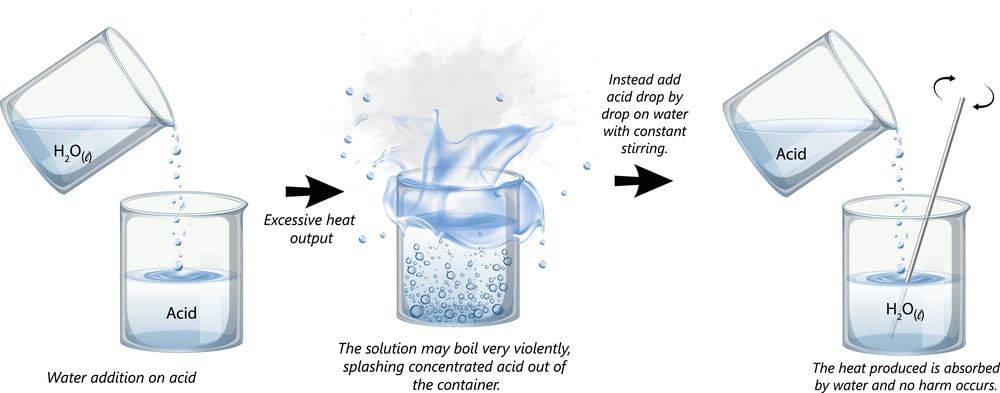Weakly acidic pharmaceutical substances may be titrated effectively using a suitable nonaqueous solvent with a sharp end-point. The wide spectrum of such organic compounds includes: anhydride, acids, amino acids, acid halides, enols, phenols, xanthenes, sulphonamides, imides, and some organic salts of inorganic acids can be analyzed accurately.
Titrant Used for Titrations of Weak Acids:
Solution of potassium methoxide sodium methoxide or lithium methoxide in toluenemethanol solutions are used for titration of weak acids.
1. Preparation of 0.1 M Sodium Methoxide in Toluene-Methanol:
Material Required: Absolute methanol, dry toluene, potassium metal.
Procedure: Cool down anhydrous methanol (150 mL) in ice-cold water and add freshly cut sodium metal (2.5 g) in portions. When the metal has dissolved, add a sufficient amount of toluene, previously dried over sodium wire, to produce 1000 mL.
2. Preparation of 0.1 M Potassium Methoxide: It is prepared exactly in a similar manner as 0.1 M sodium methoxide, using 5.6 g of freshly cut potassium in place of sodium.
3. Preparation of 0.1 M Lithium Methoxide: It is prepared as like as 0.1 N sodium methoxide, using 0.7 g of lithium in place of sodium.
Standardization of 0.1 N Sodium Methoxide Solution:
Material Required: Benzoic acid: 0.4 g; dimethyl formamide (DMF): 80 mL; thymolphthalein solution (0.15 mL); 0.1 M sodium methoxide.
Procedure: Standardise the solution immediately before use by dissolving accurately weighed benzoic acid (0.4 g) in dimethyl formamide (80 mL), add thymol phthalein solution (0.15 mL) and titrate with 0.1 M sodium methoxide solution to a blue endpoint.
A blank titration is also performed on the solvent system to account for acidic impurity in dimethyl formamide and the correction is made accordingly.
1 mL of 0.1M CH3ONa ≅ 0.01221 g of C6H5COOH
Interaction between sodium metal and methanol is an exothermic reaction and therefore, special care must be taken while adding the metal into the dry solvent in small lots at intervals with adequate cooling to keep the reaction well under control.
Na+ + CH3OH → CH3ONa + H+
The clear solution of sodium methoxide must be kept away from moisture and atmospheric CO2 to avoid following two chemical reactions that might ultimately result in the formation of turbidity.
H2O + CH3ONa → CH3OH + NaOH
H2CO3 + 2CH3ONa → 2CH3OH + Na2CO3
In a chemical reaction,
Step 1: Benzoic acid (primary standard) dissolved in DMF,
C6H5COOH + H-CON(CH3)2 ⇌ H-CON+H(CH3)2 + C6H5COO− … (1)
Step 2: Ionization of sodium methoxide,
CH3ONa ⇌ CH3O− + N+ … (2)
Step 3: Interaction between the solvated proton and the methylated ion,
H-CON+H(CH3)2 + CH3O− → H-CON(CH3)2 + CH3OH … (3)
By adding reactions 1, 2, and 3,
C6H5COOH + CH3ONa → C6H5COONa + CH3OH
In summing up, the net reaction between the water in the solvent (DMF) and the titrant is equivalent to the volume of sodium methoxide consumed by DMF or may be considered as a blank determination.
4. Preparation of 0.1N Potassium Hydroxide in Methanol:
Dissolve 5.6 gm of anhydrous potassium hydroxide in 1000 mL of anhydrous methanol. This titrant is not more advantageous than others. The main disadvantage of this titrant is that it reacts with acidic functional groups and produces a molecule of water, which would affect the sensitivity of the titration.
Standardization: A sufficient amount of benzoic acid AR-grade is transferred in a dry flask and dissolved in 25 mL dimethyl formamide, add 2-3 drops of 0.5% thymol blue indicator in dry methanol and titrate with 0.1N potassium hydroxide in methanol. A blank titration is also performed in the solvent to account for acidic impurity in dimethyl formamide and the correction is made accordingly.
5. Preparation of 0.1 N Tetrabutylammonium Hydroxide in Toluene-Methanol:
Materials Required: Tetrabutylammonium iodide: 40 g; absolute methanol: 90 mL; silver oxide: 25 g; dry toluene: 150 mL.
Procedure: Carefully dissolve 40 g of tetrabutylammonium iodide (Bu4NI) in 90 mL of absolute methanol, add 20 g of finely powdered purified silver oxide, and finally shake the mixture thoroughly for 1 hour. Centrifuge about 2-3 mL of the resultant mixture and test for iodide in the supernatant liquid. In case, it gives a positive test, add about 2 g more of silver oxide and shake for an additional period of 30 minutes. The said method may be repeated until the supernatant liquid obtained is completely free from iodide. The mixture thus obtained is filtered through a fine sintered glass filter and finally the container with three portions, each of 50 mL of dry toluene. These washings may be added to the filtrate and the final volume is made up to 1 liter with dry toluene. The clear solution should be kept duly protected from both CO2 and moisture during storage.
2 Bu4NI + Ag2O + H2O → 2 Bu4NO + 2Agl
Make sure you also check our other amazing Article on : Assay of Amitriptyline Hydrochloride
